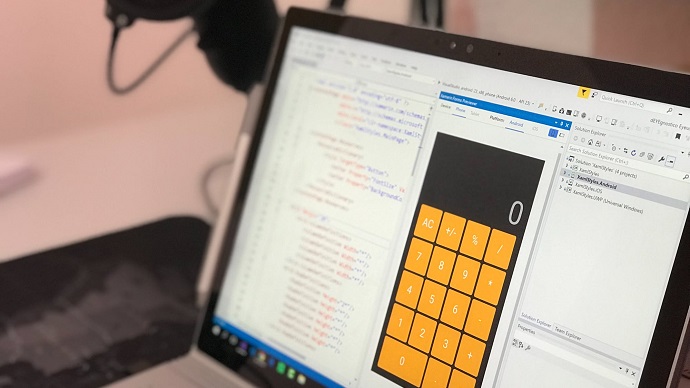
300-435: Automating Cisco Enterprise Solutions (ENAUTO)
PDFs and exam guides are not so efficient, right? Prepare for your Cisco examination with our training course. The 300-435 course contains a complete batch of videos that will provide you with profound and thorough knowledge related to Cisco certification exam. Pass the Cisco 300-435 test with flying colors.

Curriculum for 300-435 Certification Video Course
| Name of Video | Time |
|---|---|
 1. ENAUTO Introduction |
4:00 |
 2. Find the Topics |
7:00 |
 3. Section 1.0 Network Programmability Foundation |
4:00 |
 4. Introduction to git |
7:00 |
 5. Lab using GNS3 |
9:00 |
 6. git Lab |
5:00 |
 7. Git Architecture & GitHub |
5:00 |
 8. 1.2 What is API |
7:00 |
 9. REST Representational state transfer |
9:00 |
 10. gRPC |
1:00 |
 11. 1.3 Syncronous vs asyncrhonous APIs |
6:00 |
 12. 1.4 Python Basics |
1:00 |
 13. Let's Learn Python |
11:00 |
 14. Python Conceptual Hierarchy |
8:00 |
 15. 1.5 Python Virtual Environment |
9:00 |
 16. 1.6 Explain Benefits of Ansible & Puppet |
7:00 |
| Name of Video | Time |
|---|---|
 1. 2.0 Automate APIs & Protocols |
1:00 |
 2. Evolution of Network Mgmt |
11:00 |
 3. Model Driven Programming |
6:00 |
 4. JSON |
12:00 |
 5. XML |
9:00 |
 6. Data Models |
5:00 |
 7. Yet Another Next Generation YANG |
6:00 |
 8. Model Driven Programming Protocols |
3:00 |
 9. Netconf |
12:00 |
 10. Restconf |
7:00 |
| Name of Video | Time |
|---|---|
 1. 27 3.0 Network Device Programmability |
1:00 |
 2. 28 3.1 Netmiko Intro |
3:00 |
 3. 29 Lab Setup over GNS3 |
10:00 |
 4. 30 Lab Setup over GNS3 Part 02 |
18:00 |
 5. 31 Build Basic Lab Install Python |
9:00 |
 6. 32 Check Python is Running in the Lab Install Netmiko |
3:00 |
 7. 33 SSH via Netmiko |
3:00 |
 8. 34 Do the SSH via Netmiko |
15:00 |
 9. 35 Add more Commands via Netmiko |
10:00 |
 10. 36 SSH to Multiple Devices |
9:00 |
 11. 37 Run Bulk Commands via SSH |
13:00 |
 12. 38 ncclient to Configure IOX-XE Devcies |
3:00 |
 13. 39 Lab ncclient IOS-XE |
16:00 |
 14. 40 3.3 Configure Device via RESTCONF API Python |
1:00 |
 15. 41 Lab Task Integrating Python API --1 |
2:00 |
 16. 42 Lab Task Integrating Python API --2 |
15:00 |
 17. 43 3.4 using Ansible configure IOS-XE |
7:00 |
 18. 44 Install Ansible Centos |
5:00 |
 19. 45 Ansible IOS-XE Lab |
10:00 |
 20. 3.5 Model Driven Telemetry |
14:00 |
 21. Network Subscription |
9:00 |
 22. Model Driven Telemetry Lab Devnet |
17:00 |
 23. 3.8 iPXE |
7:00 |
 24. ZTP SDWAN |
7:00 |
 25. ZTP Lab |
10:00 |
 26. PnP SDWAN |
10:00 |
| Name of Video | Time |
|---|---|
 1. 5.0 SDWAN API |
2:00 |
 2. SDWAN API 01 |
10:00 |
 3. SDWAN API 02 |
4:00 |
 4. 5.1 vManage Certificate Administration |
13:00 |
 5. 5.2 SDWAN API integration with Python Part 01 |
8:00 |
 6. 5.2 SDWAN API integration with Python part 02 |
6:00 |
 7. 5.2 SDWAN API integration with Python part 03 |
5:00 |
 8. 5.3 vmanage administration api |
5:00 |
 9. 5.4 Implement Python Script to Configure SDWAN with API Part 01 |
11:00 |
 10. 5.4 Implement Python Script to Configure SDWAN with API Part 02 |
17:00 |
 11. 5.5 vManage Monitoring API |
14:00 |
 12. 5.6 vManage troubleshooting API |
14:00 |
Cisco ENAUTO 300-435 Exam Dumps, Practice Test Questions
100% Latest & Updated Cisco ENAUTO 300-435 Practice Test Questions, Exam Dumps & Verified Answers!
30 Days Free Updates, Instant Download!
300-435 Premium Bundle

- Premium File: 171 Questions & Answers. Last update: Nov 23, 2025
- Training Course: 64 Video Lectures
- Latest Questions
- 100% Accurate Answers
- Fast Exam Updates
Cisco 300-435 Training Course
Want verified and proven knowledge for Automating Cisco Enterprise Solutions (ENAUTO)? Believe it's easy when you have ExamSnap's Automating Cisco Enterprise Solutions (ENAUTO) certification video training course by your side which along with our Cisco 300-435 Exam Dumps & Practice Test questions provide a complete solution to pass your exam Read More.
Master Cisco Network Automation with Cisco 300-435 ENAUTO Training
Assess Your Expertise with Verified Questions for Cisco CCNP Enterprise
Course Overview
The Cisco 300-435 course, also known as ENAUTO, is designed for network engineers and IT professionals who aim to master network automation in modern enterprise environments. This course provides a structured learning path to understand, implement, and troubleshoot automation solutions across Cisco networks. As organizations increasingly rely on automation to improve network efficiency and reduce operational errors, the ENAUTO certification serves as a key benchmark for validating skills in network programmability and automation workflows.
Throughout the course, participants will explore the fundamental concepts of network automation, including programmability, scripting, API usage, and integration with Cisco automation platforms. By completing this training, learners will gain hands-on experience with tools such as Cisco DNA Center, Cisco APIC-EM, and other DevNet resources. The course is designed not only to prepare participants for the Cisco 300-435 exam but also to provide practical knowledge applicable to real-world networking tasks.
The training emphasizes both theoretical understanding and practical application. It bridges the gap between conventional network management and modern automated processes. Students will acquire the skills needed to configure automated workflows, troubleshoot network automation issues, and leverage Cisco DevNet tools to streamline operations. This course also highlights emerging technologies in network automation, ensuring that learners stay current with industry trends.
Network automation is a vital skill in today’s IT landscape, where complex networks require efficient, error-free management. By participating in this course, learners will gain insights into how automation can transform network operations, improve scalability, and reduce the workload for network engineers. The Cisco 300-435 ENAUTO course provides the foundation needed to implement these technologies in enterprise networks and prepares participants for a career in automation-focused networking roles.
What You Will Learn From This Course
Understanding network programmability and automation concepts in Cisco environments.
Writing and executing Python scripts for network configuration and management.
Using REST APIs and YANG models to automate network device operations.
Configuring and managing automated workflows through Cisco DNA Center and APIC-EM.
Implementing network automation using DevNet sandboxes and other hands-on lab environments.
Troubleshooting automation scripts and identifying issues in automated processes.
Applying automation best practices to optimize network performance and reliability.
Integrating network automation tools with existing IT and network infrastructures.
Exploring emerging technologies and trends in Cisco network automation.
Preparing for the Cisco 300-435 exam with guided practice and simulated scenarios.
Developing skills to enhance career opportunities as a network automation engineer.
Understanding the role of automation in reducing manual errors and operational costs.
These learning outcomes are structured to ensure that participants not only gain theoretical knowledge but also practical expertise in network automation. By focusing on hands-on exercises and real-world scenarios, the course helps learners develop the confidence needed to implement automation solutions in professional environments.
Learning Objectives
The primary learning objectives of the Cisco 300-435 ENAUTO course focus on equipping participants with the skills and knowledge necessary to excel in network automation roles. By the end of this course, learners should be able to:
Explain the principles of network automation and programmability in Cisco networks.
Develop and execute Python scripts to automate network configuration tasks.
Use model-driven programmability through YANG and REST APIs for network devices.
Configure and manage automated workflows using Cisco DNA Center and APIC-EM.
Apply automation tools to monitor, manage, and troubleshoot network operations effectively.
Integrate automation processes with existing IT infrastructure to streamline operations.
Follow best practices for implementing network automation in enterprise networks.
Navigate Cisco DevNet resources and sandboxes to gain practical experience.
Analyze automation scripts to detect errors and optimize performance.
Prepare for the Cisco 300-435 exam with confidence using guided practice scenarios.
Understand the impact of network automation on operational efficiency and career growth.
Keep pace with emerging technologies and trends in Cisco network automation.
These objectives are carefully aligned with the Cisco 300-435 exam blueprint, ensuring that participants gain the knowledge required to succeed on the exam while also building practical skills applicable to real-world network environments.
Requirements
To maximize the benefits of the Cisco 300-435 ENAUTO course, learners should meet certain requirements before enrolling. These prerequisites are designed to ensure that participants have a foundational understanding of networking concepts and are prepared to engage with automation technologies effectively.
Basic knowledge of networking concepts, including IP addressing, routing, and switching.
Familiarity with Cisco networking devices and their configuration.
Understanding of network protocols such as TCP/IP, OSPF, and BGP.
Basic experience with command-line interfaces (CLI) for configuring Cisco devices.
Fundamental knowledge of programming concepts, preferably Python or similar scripting languages.
Understanding of REST APIs and their role in network automation is beneficial but not mandatory.
Access to Cisco DevNet sandboxes or similar environments for hands-on practice.
A commitment to dedicating time for practical exercises and exam preparation.
Willingness to learn emerging automation technologies and apply them in real-world scenarios.
Motivation to pursue a career in network automation or advanced Cisco networking roles.
Meeting these requirements ensures that participants can engage with the course content effectively, practice hands-on labs, and apply the learned skills in professional networking environments.
Course Description
The Cisco 300-435 ENAUTO course is a comprehensive training program focused on network automation for enterprise networks. It provides in-depth coverage of automation principles, tools, and best practices. The course begins with an introduction to network programmability, emphasizing the role of automation in modern IT operations and network management.
Participants will explore key automation technologies, including Python scripting, REST APIs, and model-driven programmability with YANG. The course also covers the use of Cisco automation platforms such as DNA Center and APIC-EM, providing learners with hands-on experience in configuring and managing automated workflows. By simulating real-world scenarios, students develop the skills needed to implement automation solutions in enterprise networks.
Practical exercises are a cornerstone of the course. Learners work in Cisco DevNet sandboxes to execute automation scripts, configure devices, and troubleshoot workflows. These hands-on labs reinforce theoretical knowledge and prepare participants for practical challenges they may encounter in professional environments.
In addition to technical skills, the course emphasizes the strategic value of automation in networks. Participants learn how automation reduces operational errors, improves efficiency, and supports the scalability of complex network infrastructures. This focus ensures that learners understand both the technical and organizational impact of network automation.
Throughout the course, participants receive guidance on exam preparation for the Cisco 300-435 certification. This includes practice questions, scenario-based exercises, and tips from experienced network engineers who have successfully implemented automation solutions in enterprise networks. By combining technical knowledge, practical experience, and exam-focused preparation, the course equips learners to achieve certification and apply automation skills effectively.
Target Audience
The Cisco 300-435 ENAUTO course is designed for a diverse group of IT professionals and network engineers who are interested in enhancing their automation skills. The training is particularly valuable for individuals seeking to advance their careers in Cisco networking and network automation.
Network engineers looking to transition into automation-focused roles.
IT professionals responsible for managing enterprise networks.
Cisco-certified professionals aiming to earn the ENAUTO certification.
Developers interested in network programmability and integration with Cisco platforms.
Systems administrators seeking to streamline network operations through automation.
Technical leads and managers responsible for implementing network automation strategies.
Students or professionals pursuing a career path in Cisco DevNet and automation technologies.
Anyone looking to gain hands-on experience with Cisco DNA Center, APIC-EM, and related tools.
The course provides a structured path for participants to acquire both theoretical knowledge and practical skills, making it suitable for individuals at various stages of their networking careers. By targeting these audiences, the training ensures that learners can apply automation concepts effectively in real-world environments.
Prerequisites
To succeed in the Cisco 300-435 ENAUTO course, participants should meet certain prerequisites that provide a foundation for understanding network automation concepts. These prerequisites ensure that learners can engage with the material effectively and maximize the value of the training.
Understanding of basic networking concepts, including IP addressing, subnetting, routing, and switching.
Familiarity with Cisco networking devices, such as routers, switches, and controllers.
Basic knowledge of network protocols like TCP/IP, OSPF, BGP, and EIGRP.
Experience with command-line interface (CLI) configuration and troubleshooting.
Foundational programming knowledge, preferably Python, for writing automation scripts.
Exposure to APIs and their use in network programmability.
Access to Cisco DevNet sandbox environments for hands-on lab exercises.
Willingness to engage with scenario-based exercises and problem-solving tasks.
Commitment to continuous learning and keeping up with emerging network automation technologies.
Motivation to pursue the Cisco 300-435 certification and apply automation skills professionally.
Meeting these prerequisites ensures that learners can fully benefit from the course content, participate in labs effectively, and achieve the practical skills necessary for both the Cisco 300-435 exam and professional network automation tasks.
Course Modules/Sections
The Cisco 300-435 ENAUTO course is organized into structured modules that guide learners through the essential concepts of network automation. Each module builds upon the previous one, gradually increasing in complexity to ensure a thorough understanding of automation technologies and their application in enterprise networks.
The first module introduces network programmability and the principles of automation. Students learn how modern networks operate in automated environments and gain insight into the benefits of reducing manual intervention in network management. This foundational module establishes the concepts of model-driven programmability, the role of APIs, and the importance of using automation tools to streamline network operations.
The second module dives into scripting and programming, with a focus on Python. Learners gain hands-on experience writing scripts that can configure, monitor, and troubleshoot network devices. This module also covers the integration of Python with Cisco network platforms, showing how scripts can interact with APIs to perform automated tasks efficiently. Through practical exercises, students develop confidence in translating theoretical automation knowledge into actionable network solutions.
In the third module, participants explore Cisco automation platforms, including DNA Center and APIC-EM. This module emphasizes the deployment and management of automated workflows, enabling learners to understand how enterprise networks leverage these tools to maintain consistency and reliability. Detailed lab exercises allow participants to simulate real-world scenarios, such as configuring devices across multiple sites and monitoring network performance through automated processes.
The fourth module addresses advanced automation techniques, such as using YANG data models, RESTCONF, and NETCONF protocols. Participants learn to integrate these technologies into automation workflows to achieve high levels of network efficiency. The module also covers troubleshooting automation scripts, ensuring that students can identify and resolve issues in automated network processes.
The final module prepares students for the Cisco 300-435 exam by focusing on exam objectives, practice exercises, and scenario-based questions. This module provides guidance on how to approach the exam, manage time effectively, and use practical experience from previous modules to answer questions confidently. By the end of this section, learners will have a comprehensive understanding of both the theoretical and practical aspects of network automation.
Key Topics Covered
The Cisco 300-435 ENAUTO course covers a wide range of topics designed to provide a deep understanding of network automation. These topics are aligned with the exam blueprint and focus on both technical skills and practical applications.
Network Automation Fundamentals: Participants explore the basics of automation, including network programmability, model-driven approaches, and the role of APIs in configuring and managing devices. This foundational knowledge helps learners understand why automation is critical in modern enterprise networks.
Python for Network Automation: This topic covers writing scripts to automate network tasks. Students learn to create, execute, and debug Python scripts that interact with network devices, reducing the need for manual configuration and troubleshooting. Practical exercises reinforce the concepts and build confidence in applying Python in real-world scenarios.
REST APIs and YANG Data Models: Learners gain experience using REST APIs and YANG data models to manage network devices programmatically. The course covers the differences between RESTCONF and NETCONF protocols and demonstrates how they are used to achieve automated configuration and monitoring.
Cisco DNA Center and APIC-EM Automation: Participants explore Cisco’s automation platforms, learning to deploy workflows, configure devices, and monitor network operations. Hands-on labs provide practical experience in using these platforms to automate tasks that would otherwise require manual effort.
Troubleshooting Automated Networks: This topic focuses on identifying and resolving issues in automated network workflows. Students learn to analyze automation scripts, detect errors, and implement solutions to maintain network reliability.
Integration with IT Infrastructure: Learners explore how network automation integrates with existing IT systems. This includes connecting automated workflows with monitoring tools, orchestration platforms, and cloud-based services to create seamless operations.
Emerging Trends in Network Automation: The course highlights new technologies and methodologies in automation, including DevOps principles, continuous integration, and emerging Cisco tools. Students gain insights into how the field is evolving and how to stay current with industry developments.
Exam Preparation and Practice Scenarios: Students engage with scenario-based exercises and practice questions designed to mimic the Cisco 300-435 exam. These exercises reinforce learning from previous modules and provide practical experience in solving problems under exam conditions.
By covering these key topics, the course ensures that learners acquire the knowledge and skills needed to succeed in both the exam and professional network automation roles. The topics are presented in a logical sequence, gradually building expertise from foundational concepts to advanced techniques.
Teaching Methodology
The teaching methodology for the Cisco 300-435 ENAUTO course is designed to provide an interactive and practical learning experience. It combines lectures, hands-on labs, scenario-based exercises, and guided practice to ensure that learners can apply automation concepts effectively.
Lectures and Conceptual Learning
The course begins with instructor-led lectures that introduce network automation concepts and the theoretical foundations of Cisco programmability. Lectures are designed to provide clear explanations, examples, and real-world context, helping students understand why automation is essential in enterprise networks. Visual aids, diagrams, and case studies are used to reinforce key concepts and ensure comprehension.
Hands-On Labs
Hands-on labs are a central component of the teaching methodology. Students work with Cisco DNA Center, APIC-EM, and DevNet sandbox environments to practice automation tasks. Labs include configuring devices through Python scripts, deploying automated workflows, and troubleshooting network issues. These practical exercises allow learners to apply theoretical knowledge in controlled, real-world scenarios, building confidence and proficiency.
Scenario-Based Exercises
Scenario-based exercises simulate real network environments, challenging students to solve problems using automation tools and techniques. These exercises encourage critical thinking and problem-solving skills, allowing participants to understand how automation is applied in practical situations. Scenarios may include tasks such as automating device configurations across multiple sites, monitoring network performance, or integrating automation workflows with IT systems.
Guided Practice and Feedback
Throughout the course, instructors provide guided practice sessions, offering feedback on lab exercises and script development. This methodology ensures that learners understand their mistakes, improve their skills, and gain confidence in applying automation solutions independently. Feedback is also provided on exam-style questions, helping students refine their approach and test-taking strategies.
Self-Paced Learning and Resources
In addition to instructor-led sessions, the course offers self-paced learning resources, including practice labs, documentation, and sample scripts. These materials allow learners to review content, practice at their own pace, and reinforce concepts outside of structured class time. Access to Cisco DevNet resources ensures that students can explore automation tools and platforms in a flexible, hands-on manner.
Collaborative Learning
Collaborative learning is encouraged through group exercises and discussion forums. Participants share insights, troubleshoot scripts together, and collaborate on scenario-based challenges. This methodology fosters peer learning, exposes students to diverse problem-solving approaches, and helps build a professional network of automation-focused peers.
Assessment & Evaluation
Assessment and evaluation in the Cisco 300-435 ENAUTO course are designed to measure both theoretical knowledge and practical skills. The evaluation process ensures that learners are prepared for the Cisco 300-435 exam and capable of applying automation concepts in real-world environments.
Continuous Assessment
Throughout the course, students undergo continuous assessment through quizzes, lab evaluations, and scenario-based exercises. These assessments provide immediate feedback, allowing learners to identify areas for improvement and track progress over time. Continuous assessment reinforces learning and ensures that participants retain knowledge from each module.
Lab Performance Evaluation
Hands-on lab exercises are evaluated based on accuracy, efficiency, and adherence to best practices. Instructors assess participants’ ability to execute Python scripts, deploy automated workflows, and troubleshoot issues effectively. Lab performance evaluation emphasizes practical application and ensures that students can implement automation solutions confidently.
Scenario-Based Assessments
Scenario-based assessments simulate real-world network environments, requiring learners to solve complex problems using automation tools and techniques. These assessments test critical thinking, problem-solving, and technical proficiency. Participants are evaluated on their ability to apply knowledge to achieve specific automation outcomes, reflecting the practical demands of network automation roles.
Exam-Style Practice Questions
To prepare students for the Cisco 300-435 certification exam, the course includes exam-style practice questions and timed exercises. Participants are evaluated on their ability to answer questions accurately, manage time effectively, and apply theoretical knowledge to practical scenarios. This evaluation method ensures that learners are familiar with the exam format and confident in their ability to succeed.
Feedback and Remediation
Instructors provide detailed feedback on all assessments, highlighting strengths and areas for improvement. Remediation sessions are offered to address gaps in knowledge or practical skills, ensuring that all learners achieve competency in network automation concepts. Feedback-driven learning helps students refine their approach, improve performance, and gain confidence in both exam and real-world environments.
Final Evaluation
The final evaluation combines theoretical assessments, practical lab performance, and scenario-based exercises. This comprehensive assessment ensures that learners have mastered the key topics, developed practical automation skills, and are prepared for the Cisco 300-435 exam. Participants who successfully complete the evaluation are well-equipped to apply automation knowledge in professional networking roles.
Benefits of the Course
The Cisco 300-435 ENAUTO course provides numerous benefits to network engineers and IT professionals seeking to enhance their skills in network automation. By completing this course, participants gain both technical knowledge and practical experience that can significantly impact their careers.
One of the primary benefits of the course is the ability to understand and implement network automation solutions across Cisco enterprise environments. Network engineers learn to use Python scripts, REST APIs, and model-driven programmability to configure, monitor, and troubleshoot network devices. This skill set reduces reliance on manual configuration, improves operational efficiency, and minimizes the likelihood of errors in network management.
Another significant benefit is enhanced career opportunities. Professionals who earn the Cisco 300-435 certification demonstrate expertise in network automation, a skill increasingly in demand in modern IT environments. Certified individuals are well-positioned for roles such as network automation engineer, DevNet engineer, and advanced Cisco network specialist. The certification serves as a recognized benchmark of expertise, giving professionals a competitive advantage in the job market.
Hands-on experience with Cisco automation platforms is another critical advantage of the course. Participants work with Cisco DNA Center, APIC-EM, and DevNet sandbox environments, gaining practical knowledge of real-world automation workflows. This experience prepares learners for both the Cisco 300-435 exam and professional responsibilities in enterprise networks.
The course also promotes understanding of emerging technologies and trends in network automation. Students explore DevOps principles, continuous integration, and other modern methodologies that are transforming network operations. By staying current with these trends, learners ensure that their skills remain relevant and adaptable to evolving IT landscapes.
Additionally, the course encourages the development of problem-solving and critical thinking skills. Through scenario-based exercises and lab simulations, participants learn to identify issues in automated workflows, troubleshoot scripts, and optimize network performance. These competencies are highly valuable for professionals managing complex enterprise networks and contribute to improved operational decision-making.
Networking and collaboration opportunities are another key benefit. Participants engage in group exercises, discussions, and peer learning sessions, which allow them to share experiences, exchange ideas, and build a professional network of automation-focused peers. This collaborative environment enhances learning and provides access to a community of professionals with shared interests and expertise.
Finally, the Cisco 300-435 ENAUTO course provides structured guidance for exam preparation. Participants receive practice questions, exam scenarios, and instructor-led feedback that help them approach the Cisco 300-435 exam with confidence. This preparation ensures that learners can apply both theoretical knowledge and practical skills to achieve certification successfully
Course Duration
The Cisco 300-435 ENAUTO course is designed to provide comprehensive coverage of network automation topics within a structured timeframe. The total course duration typically ranges from four to six weeks, depending on the learning format, pace, and depth of engagement with hands-on labs and practice exercises.
For instructor-led programs, the course often consists of multiple sessions spread over several weeks, allowing participants to learn new concepts, practice skills, and review material between classes. Each session focuses on specific modules, including network programmability, Python scripting, automation platform usage, and troubleshooting automated workflows. Spacing sessions over multiple weeks enables learners to retain knowledge effectively and apply it in practical exercises.
Self-paced learning options are also available for participants who prefer flexible schedules. These options allow learners to progress through course materials, labs, and practice exercises at their own pace. Self-paced formats typically include access to video lectures, lab environments, study guides, and practice exams, providing flexibility for professionals balancing work commitments or personal schedules. The overall duration may vary depending on the learner’s engagement level and time dedication.
The duration of hands-on labs and scenario-based exercises is a critical consideration in planning the course schedule. Practical exercises provide the opportunity to implement automation workflows, write scripts, and troubleshoot network devices. These exercises require dedicated time for experimentation, repetition, and refinement, which is essential for mastering the skills needed to succeed in professional network automation roles.
Additionally, exam preparation and practice sessions are included in the course duration. Participants spend time reviewing Cisco 300-435 exam objectives, practicing scenario-based questions, and refining their problem-solving strategies. This preparation ensures that learners can approach the certification exam confidently and effectively demonstrate their knowledge and skills.
Course duration is designed to balance theoretical instruction with practical application, ensuring that participants gain a comprehensive understanding of network automation. By the end of the program, learners are expected to have developed proficiency in Python scripting, API integration, workflow automation, troubleshooting, and the use of Cisco automation platforms. The structured timeline ensures that learners are adequately prepared for both the exam and real-world network automation challenges.
Tools & Resources Required
Successful participation in the Cisco 300-435 ENAUTO course requires access to specific tools and resources that support both theoretical learning and hands-on practice. These resources ensure that learners can implement automation workflows, execute scripts, and gain practical experience in a controlled environment.
One essential tool is Python, which serves as the primary scripting language for network automation tasks. Participants should have access to a Python development environment, such as IDLE, PyCharm, or VS Code, to write, test, and debug scripts. Familiarity with Python libraries relevant to network automation, such as Netmiko, NAPALM, and Requests, is beneficial for executing automation workflows on Cisco devices.
Access to Cisco DNA Center and APIC-EM platforms is another critical resource. These tools provide the infrastructure for configuring automated workflows, managing network devices, and monitoring network performance. Hands-on experience with these platforms allows learners to apply theoretical concepts in real-world scenarios, such as automating device configurations and orchestrating network operations.
DevNet sandbox environments are highly recommended for practical exercises. These sandboxes offer pre-configured network topologies where participants can safely test scripts, experiment with automation workflows, and simulate enterprise network scenarios. DevNet resources also include API documentation, sample scripts, and lab guides that enhance the learning experience.
Network devices such as routers, switches, and controllers may also be required for lab exercises, depending on the course format. Participants may use physical equipment or virtualized environments to practice configuration, deployment, and troubleshooting tasks. Virtual labs offer flexibility and reduce the need for extensive hardware, allowing learners to experiment in a controlled setting.
Documentation and study guides are vital resources for exam preparation and conceptual understanding. Official Cisco guides, course materials, and reference documents provide detailed explanations of automation concepts, API usage, and platform-specific workflows. These resources serve as a foundation for both learning and revision, ensuring that participants can confidently approach the Cisco 300-435 exam.
Collaboration and discussion platforms enhance the learning experience by allowing participants to interact with instructors and peers. Online forums, chat groups, and discussion boards enable learners to ask questions, share insights, and collaborate on scenario-based exercises. This engagement fosters peer learning, encourages knowledge sharing, and helps participants troubleshoot challenges encountered during labs and practice exercises.
Additional tools include network simulation and visualization software, such as Cisco Packet Tracer or GNS3, which allow learners to simulate network topologies and practice automation workflows in a virtual environment. These tools provide opportunities to experiment with complex network scenarios, monitor traffic flows, and validate automation scripts without impacting live networks.
Finally, access to practice exams and assessment platforms is crucial for evaluating progress and readiness for the Cisco 300-435 certification exam. These resources offer timed quizzes, scenario-based questions, and simulated exam conditions, allowing learners to test their knowledge and identify areas for improvement. Practice assessments also provide feedback and guidance on how to approach questions effectively during the actual exam.
By combining these tools and resources, participants gain a well-rounded learning experience that encompasses both theoretical understanding and practical application. Access to Python scripting environments, Cisco automation platforms, DevNet sandboxes, documentation, collaborative platforms, and practice exams ensures that learners can fully engage with the course content, develop practical skills, and achieve success in both professional network automation roles and the Cisco 300-435 certification exam.
Career Opportunities
Completing the Cisco 300-435 ENAUTO course opens a range of career opportunities for IT professionals and network engineers who wish to specialize in network automation. As organizations increasingly adopt automated network operations, the demand for skilled professionals who can configure, manage, and troubleshoot automated workflows continues to grow.
Network engineers who earn the ENAUTO certification are positioned for roles such as network automation engineer, Cisco automation specialist, DevNet engineer, and advanced network architect. These roles require proficiency in scripting, API integration, and the use of automation platforms, all of which are core components of the Cisco 300-435 training.
Professionals with this certification are also well-suited for positions that involve designing and deploying automation solutions for enterprise networks. By leveraging Cisco DNA Center, APIC-EM, and DevNet tools, certified engineers can streamline network operations, reduce manual configuration errors, and enhance overall network performance. Organizations highly value these skills, making certified professionals more competitive in the job market.
In addition to technical roles, the certification can support career advancement in leadership or strategic positions within IT and network departments. Knowledge of automation workflows and emerging technologies allows professionals to contribute to network transformation initiatives, optimize operational efficiency, and lead teams focused on implementing automation best practices.
The certification also provides opportunities for cross-functional collaboration with software developers, system administrators, and DevOps teams. This interdisciplinary expertise enhances professional versatility, making certified individuals valuable contributors to integrated IT projects that rely on automation for scalability and reliability.
Global demand for network automation expertise continues to rise, creating opportunities across industries such as finance, healthcare, technology, and telecommunications. Certified professionals can pursue roles in multinational corporations, managed service providers, and government agencies where automated network management is critical for operational success.
Overall, the Cisco 300-435 ENAUTO course equips learners with the knowledge and practical skills needed to access a wide range of career paths. Whether focusing on technical engineering, network architecture, or strategic IT leadership, certified professionals gain credibility, marketability, and the confidence to excel in automation-focused network roles.
Enroll Today
Enrolling in the Cisco 300-435 ENAUTO course is the first step toward mastering network automation and achieving career advancement in Cisco networking. The course is structured to provide a balance of theoretical learning, hands-on practice, and exam preparation, ensuring that participants gain both the knowledge and skills needed to succeed in professional roles.
Registration for the course is straightforward, with options for instructor-led training, self-paced learning, or blended programs. Prospective participants can select the format that best aligns with their schedule, learning style, and professional commitments. Instructor-led programs offer interactive sessions and real-time guidance, while self-paced options provide flexibility for learners to study and practice at their convenience.
Once enrolled, participants gain access to comprehensive course materials, including video lectures, lab exercises, study guides, and practice questions aligned with the Cisco 300-435 exam objectives. Access to Cisco DevNet sandboxes and automation tools ensures that learners can practice real-world scenarios in a safe, controlled environment.
Learners are encouraged to take advantage of collaborative learning opportunities, such as discussion forums, peer exercises, and guided lab sessions. These interactions enhance understanding, provide insights into industry best practices, and create a supportive learning community for automation-focused professionals.
By enrolling today, participants can begin building proficiency in Python scripting, REST API integration, workflow automation, and troubleshooting techniques. These skills not only prepare learners for the Cisco 300-435 exam but also provide immediate value for managing enterprise networks efficiently and effectively.
Early enrollment ensures that learners can progress at a comfortable pace, complete modules systematically, and engage fully with hands-on labs and scenario-based exercises. Whether preparing for certification or seeking to enhance professional expertise, enrolling in the course represents a strategic investment in career growth and network automation proficiency.
Taking the step to enroll also demonstrates commitment to continuous learning and professional development. In a field where technology evolves rapidly, staying ahead with automation skills ensures that professionals remain competitive and relevant in the industry. Enrolling in the Cisco 300-435 ENAUTO course positions learners to gain recognition, expand career opportunities, and contribute meaningfully to the future of automated network management.
Prepared by Top Experts, the top IT Trainers ensure that when it comes to your IT exam prep and you can count on ExamSnap Automating Cisco Enterprise Solutions (ENAUTO) certification video training course that goes in line with the corresponding Cisco 300-435 exam dumps, study guide, and practice test questions & answers.
Purchase Individually



Cisco Training Courses




















Only Registered Members can View Training Courses
Please fill out your email address below in order to view Training Courses. Registration is Free and Easy, You Simply need to provide an email address.
- Trusted by 1.2M IT Certification Candidates Every Month
- Hundreds Hours of Videos
- Instant download After Registration






